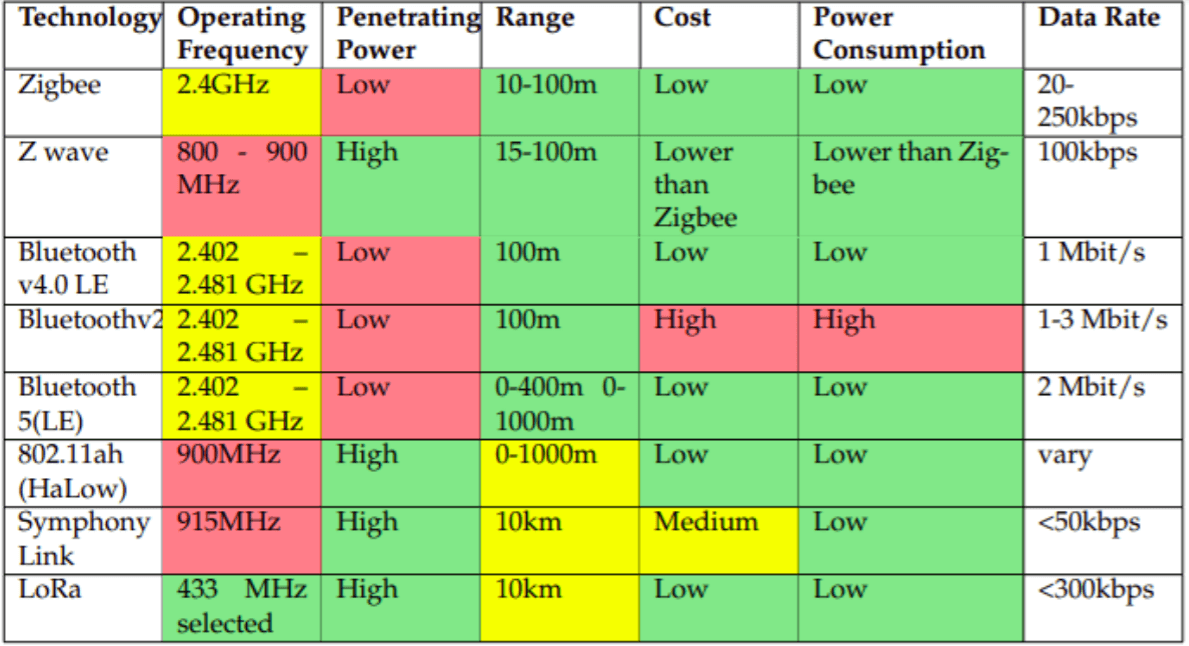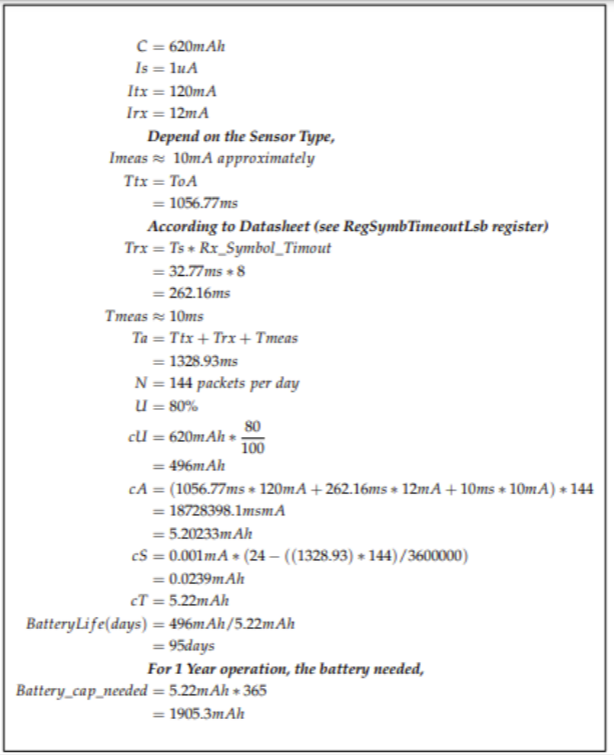Introduction
This article is about the things We learnt about LoRa during my Internship Period at Senzmate (PVT) Ltd. The follwing key points are included in this article.
- The definition of LoRa.
- Why LoRa is selected for Reefer Monitoring System?
- How it effectively consumes power for our application

LORA DEFINITION
LoRa is the short term for Long Range and this technology is owned by the Semtech Corporation. LoRa is a modulation technique which is originated from Chirp Spread Spectrum (CSS) which is close to M-ary FSK modulation and it is operated in Sub- GHz range. Because of the use of Sub- GHz range Radio Frequency, LoRa have uses like Long Range Communication and high penetration purposes like Reefer Monitoring Systems, Underground Data Monitoring Systems etc. Unlike other protocols like Bluetooth, 2G, 3G, 4G, IEEE 802.11 and IEEE 802.15.4, LoRa cannot be operated in any other devices as it can only be operated using Semtech devices. Also, LoRa operating Sub- GHz range differs from region to region. In Sri Lanka according to the LoRaWAN 1.1 Regional Parameters document published in 2017, the allowed Sub-GHz range for LoRa is 433.05–434.79MHz. Also, Several other MAC layer protocols are also present which uses the LoRa modulation technique in the physical layer such as LoRaWAN .
WHY LORA SUITABLE FOR REEFER MONITORING SYSTEM
Following are the main requirements that we should consider when selecting a communication technique for the Reefer Container Monitoring System.
- Since a Reefer Container is an enclosed cold environment, the communication technique should be operable inside that environment
- Usually, reefer containers are thick metal containers and in the inside several foams are included to preserve the temperature inside. So, the communication technique must be able to penetrate through the reefer container.
- Since data monitoring is done inside a master room of the reefer container yard and the driver cabin, the range should be considered.
- The communication technique should be multi point to point network
- The power consumption of the slave nodes must be minimum
Following shows the comparison table We prepared after having a deep research on each of the protocols mentioned in the table.
- Spreading Factor (SF): Spreading factor is simply the number of raw bits inside a symbol. The value will vary between 6 to 12. So, the number of symbols is 2 𝑆𝐹 .
- Coding Rate (CR): To further improve the robustness of the link the LoRa modem employs cyclic error coding to perform forward error detection and correction. The value varies between 1–4
- Bandwidth (BW) : Bandwidth controls the data rate. Bandwidth is also known as the chip rate. Using BW, SF and CR we can derive the term bit rate .
- Operating Frequency (410–525MHz | Band 2)
- Cyclic Redundancy Check Mode: This option is enabled to ensure a reliable error free data transmission this option is enabled.
- ) Preamble Length.

By adjusting above parameters, we can control the power consumption, range and penetrating power up to some extent. Now let us discuss the dependencies of these parameters on the power consumption, range and the penetrating power.
4. LORA PARAMETER ADJUSTING
Semtech provides different versions of devices for different frequency bands for LoRa and some of these versions are not allowed to operate in Sri Lanka. SX1276/77/78/79 are some of the modules which are manufactured by the Semtech Corp. and we can use those modules for testing purposes in 433MHz Sub-GHz frequency band.
4.1 LoRa Parameters
In LoRa Modulation technique Semtech provides us some ways to configure LoRa modules according to our major requirement. Dedicated registers are present for that and we can set configurable parameters using those registers. The parameters that we can configure are as follows,
is equal to the Packet Delivery Time. But propagation delay also contributes for the Packet Delivery Time. Here the thing is that if propagation delay is high when compared to the ToA, then the system is not reliable. We should increase the ToA and keep the propagation delay at a lower value so that we can almost neglect the propagation delay as it is a small value when compared with that of ToA. In that instant ToA will equal to the packet delivery time and that is why it is defined as ToA by Semtech Corp. As a result, when the ToA is high, the range will be high and since the packet size increases (number of bits inside the packet) the power consumption to transmit those packets also will be increased. We must use higher spreading factor if the signal is weak, and the interference is high. LoRa usually uses higher spreading factor, and it causes a high ToA. When range needs to be high. Two nodes are far away from each other. So, the signal gets weaker and weaker during the transmission. Because of that it is better to use a high SF as when number of raw bits inside a symbol increases then the probability of packet loss get decreases as well. So, this causes to increase the reliability of the packet transmission. But increasing SF causes to decrease the bit rate. (refer Equation 1) If we consider the penetrating power, it directly depends on the transmission power. But according to the tests We carried out, 17dBm is sufficient to penetrate through a metal barrier of width 1mm and for a range of 20–25m.
So, to control the power consumption, range and the penetration power we should know how to adjust the parameters We described above. As a rule of thumb,
If the Data Rate is not much of a concern, decrease the bandwidth and the spreading factor to boost link budget and increase the coding rate to boost reliability. If the data rate is concerned, we can increase the bandwidth keeping other two at maximum levels. But the increase of BW causes to decrease the ToA and the range.
4.2 Parameters that affect the range.
- Spread Factor — High SF is preferred
- Bandwidth — For the High data rate high BW is preferred. High BW decreases the range as it decreases Time on Air (ToA).
- Packet Length — Packet Length directly affect to ToA, as a result range increases with packet length.
- Coding Rate — When Coding rate increased, the Time on Air increases and cause to increase the reliability of the packets as well. This results range expansion.
- Transmitting Power — This factor is also configurable with some limitations. For SX1278 the configurable transmit powers are in the range of 11dBm to 20dBm.
Here an important parameter is derived using above parameters called Time on Air (ToA). Time on Air is the amount of time needed to transmit the packet from the transmitter to the receiver. This directly affects the power consumption of the module and the range of the module. But this power consumption is much less when compared with Bluetooth, WiFi, GSM, 3G, 4G LTE and 5G. By using the Equation 2, we can derive the ToA value. Here Tpacket is the amount of time required to transmit a single packet including preamble and payload. Now you may think that the Equation 2 contradicts with the definition mentioned in above paragraph about ToA. But in the actual scenario the term propagation delay also contributes to the packet delivery time. Here, if the system is ideal then there is no propagation delay and the ToA
- Trx = Amount of time that device is in Receive (RX) mode (ms)
- Tmeas = Amount of time that device is in measurement mode (ms) [depends on technology used and application]
- Ta = Amount of time that device is active (ms)
- Ta = Ttx+ Trx +Tmeas
- • U = Usable capacity after taking into account self-discharge (%)
- N = Number of times the device will be active per day
- cU = Capacity after taking into account discharge rate (mAh) = C*(U/100)
- T = Milliseconds per hour = 3600000
- cA = Active capacity usage per day = N*(Ttx*Itx + Trx*Irx + Tmeas*Imeas)
- cS = Sleep capacity usage per day = Is*( 24-((Ttx + Trx + Tmeas)*N/T) )
- cT = Total capacity consumed per day = cA+cS
- Battery Life (days) = (cU/cT)/24
Battery Life (years) = days/365.24
5. POWER CONSUMPTION CALCULATION
According to the configuration we used as We discussed above, we can calculate the power required. Here the Semtech Corp. gives us a procedure as a description, and We will clearly describe that process in this article.
First, we must understand the variables and equations We used for the process.
- C = Battery capacity (mAh)
- BL= Battery life (years)
- Is = Current when device is in sleep mode (mA)
- Itx = Current when device is in transmit mode (mA)
- Irx = Current when device is in Receive mode (mA)
- Imeas = Current when device is in measurement mode (mA) [it depends on technology used and application]
- Ttx = Amount of time that device is in Transmit (TX) mode (ms)
Theoretically, under the lowest power configuration of SF = 7, Carrier Frequency = 433MHz, Coding Rate = 1, Bandwidth = 125kHz, Power = 11dBm, the 620mAh battery can withstand for 23 years. Under these conditions the maximum range given was 100m inside the reefer container with the interference of buildings as well.
5.1 Lowest Power Configuration checked with SX1278
Check the examples given below, Assume the battery capacity is 620mAh

5.2 Maximum Power Configuration
To increase the range as discussed before, we can increase the SF to 12, CR to 4 and power to 17dBm. The power consumption for that instant is,
Here we send the Tx packet in every 10 minutes (60000ms).Assume battery cpacity 620mAh

Here battery consumption is relatively high and for 1-year continuous operation 1905mAh battery is required. But that is also a huge reduction in power consumption if we compare that with the other protocols.
6. CONCLUSION
As a conclusion to my article, LoRa is a more flexible communication technique when compared with other long range protocols. It is flexible because we can change the parameters and change the properties as we require under certain limitations. Battery Power consumption is much less and the service we can acquire from the LoRa communication technique is much higher. For a commercialized product of Reefer Container Monitoring, LoRa is a very good option to established a wireless, stable, point to multi-point communication network.